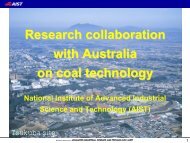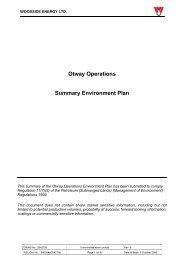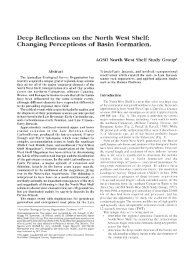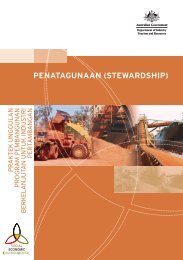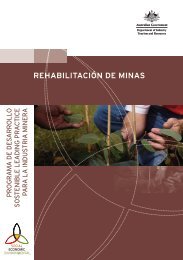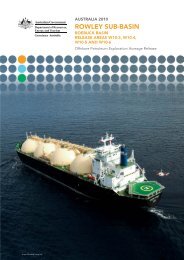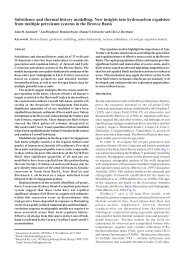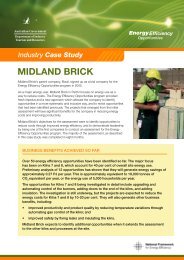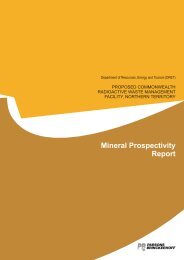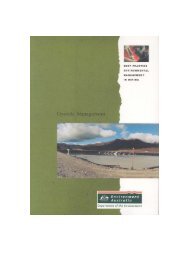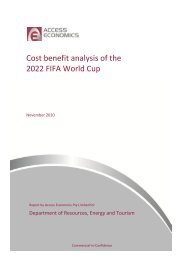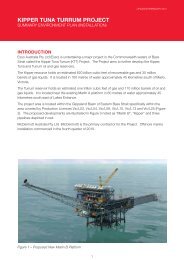A guide to leading practice sustainable development in mining
A guide to leading practice sustainable development in mining
A guide to leading practice sustainable development in mining
You also want an ePaper? Increase the reach of your titles
YUMPU automatically turns print PDFs into web optimized ePapers that Google loves.
Risk Management<br />
Risk at closure and post closure (legacy)<br />
Risks associated with closure and post-closure phases <strong>in</strong> the m<strong>in</strong>e life cycle cover<br />
both economic and non-economic consequence types. These risks are long term<br />
<strong>in</strong> nature. The expectations of the local community, government, landowners,<br />
neighbour<strong>in</strong>g property owners and non-government organisations (NGOs) need <strong>to</strong><br />
be taken <strong>in</strong><strong>to</strong> account. A well-planned and managed closure process will protect the<br />
community from un<strong>in</strong>tended consequences well after the m<strong>in</strong><strong>in</strong>g company has left<br />
the district and will protect the reputation of the company.<br />
Closure strategies for some m<strong>in</strong>e operations may <strong>in</strong>clude <strong>in</strong>itiatives <strong>to</strong> create<br />
endur<strong>in</strong>g legacies that enhance social and/or environmental values <strong>in</strong> the vic<strong>in</strong>ity<br />
of the m<strong>in</strong>e and surround<strong>in</strong>g communities. In this way, the reputation of the m<strong>in</strong><strong>in</strong>g<br />
company will be enhanced.<br />
Australia hosts examples of the long term risks of older m<strong>in</strong>es where closure wasn’t<br />
considered until relatively recent times. The Mount Lyell M<strong>in</strong><strong>in</strong>g and Railway<br />
Company Ltd copper m<strong>in</strong>e <strong>in</strong> Queens<strong>to</strong>wn, Tasmania, resulted <strong>in</strong> more than 100<br />
million cubic metres of m<strong>in</strong>e tail<strong>in</strong>gs, smelter slag and <strong>to</strong>psoil be<strong>in</strong>g deposited <strong>in</strong><strong>to</strong><br />
the K<strong>in</strong>g River and Macquarie Harbour <strong>in</strong> its 100 years of operations. Despite the<br />
cessation of tail<strong>in</strong>gs dump<strong>in</strong>g, exposed tail<strong>in</strong>gs on the river banks and <strong>in</strong> the delta<br />
cont<strong>in</strong>ually leach iron, manganese, alum<strong>in</strong>ium and copper, which have contributed<br />
substantially <strong>to</strong> the metal loads <strong>in</strong> Macquarie Harbour waters and sediments. The<br />
case study <strong>in</strong> the Lead<strong>in</strong>g Practice Risk Handbook (p.17) illustrates the outcomes of<br />
us<strong>in</strong>g risk assessment techniques <strong>in</strong> provid<strong>in</strong>g guidance <strong>in</strong> the m<strong>in</strong>e rehabilitation<br />
and closure process.<br />
Figure 5.32 - The K<strong>in</strong>g River <strong>in</strong> SW Tasmania (Image Source: Mount Lyell M<strong>in</strong><strong>in</strong>g)<br />
A GUIDE TO LEADING PRACTICE SUSTAINABLE DEVELOPMENT IN MINING 169



